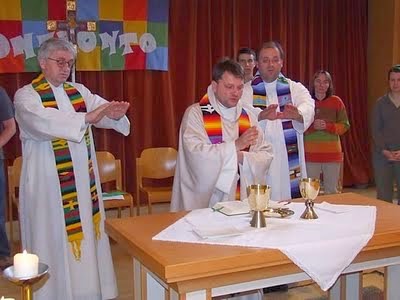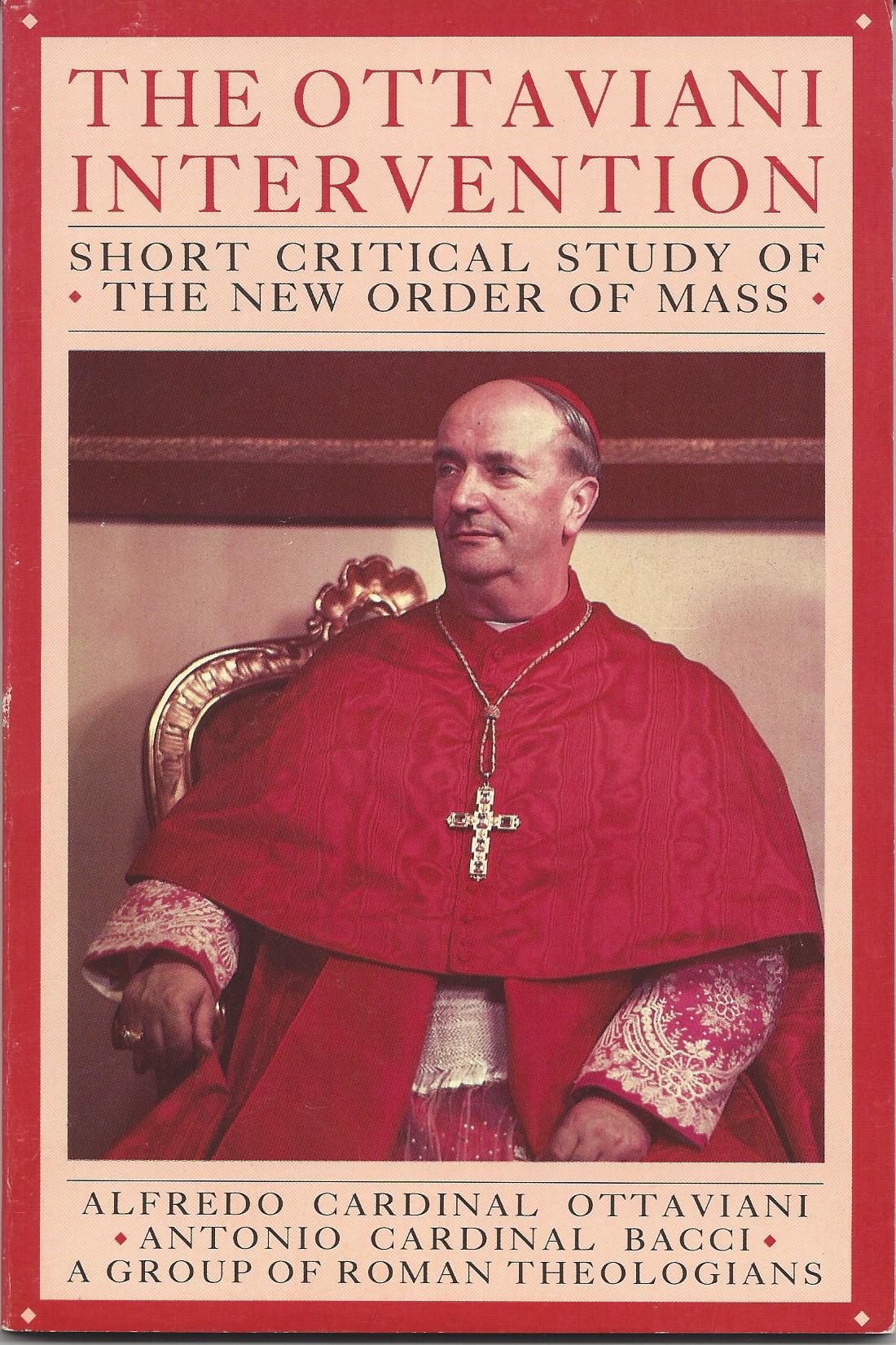
Introduction to A Critical Study of the Novus Ordo Missae “The Ottaviani Intervention”
July 16, 2017
By Dr. Peter Chojnowski
This is a preface that I did a few years ago for a new translation of the Ottaviani Intervention published by The Angelus Press. For those still attending the Novus Ordo please consider the issues raised here for the good of your own souls and for the souls of those that are dear to you. The opening quotation cited below is critical for every Catholic to keep in the forefront of their minds.
It is evident that the Novus Ordo has no intention of presenting the faith as taught by the Council of Trent, to which, nonetheless, the Catholic conscience is bound forever. With the promulgation of the Novus Ordo, the loyal Catholic is thus faced with a most tragic alternative.
This statement, made with absolute and definitive clarity, from Section VI of the Ottaviani Intervention, was made in response to what might be considered one of the most critical moments in the history of the Catholic Church since the original Pentecost Sunday, the traditional worship of the Roman Church was about to be replaced.

The issue of the ongoing liturgical revolution in the Catholic Church became critical on April 28, 1969 when Paul VI announced the Novus Ordo Missae. It was the last chance for action within the traditional channels of ecclesiastical authority. Somehow the pope had to be dissuaded from implementing this substitute for the traditional Catholic Mass of the Roman Rite. This attempt, ultimately unsuccessful, was done in The Critical Study of the New Order of the Mass (in the original Italian — Breve Esame Critico del Novus Ordo Missae) or what has become known as the “Ottaviani Intervention.” In a story little known even within traditional Catholic circles, it all began on account of the initiative of two Italian women, Cristina Campo, a writer, poet, and instigator of Una Voce Roma and Emilia Pediconi, her friend, who gathered together 5 or 6 priests, including Msgr. Renato Pozzi (a member of the Congregation for Catholic Education and a former peritus at the Council), Msgr. Gerrino Milani (a member of the Congregation for Catholic Education), and Msgr. Domenico Celada (a renowned liturgist). The compilation of their findings was entrusted to Fr. Michel Louis Guérard des Lauriers, a Dominican, professor at the Lateran University in Rome and former confessor of Pope Pius XII (1954-1955).[1] It was Archbishop Marcel Lefebvre who had brought Fr. Guèrard des Lauriers into the project.[2]
Rightly gaining the title of “author” of the Critical Study, Fr. Guérard des Lauriers dictated a text to Cristina Campo who put it into the final Italian. It was dated June 5, 1969. Advanced with the encouragement of Archbishop Lefebvre,[3] the two ladies from Una Voce attempted to gain some prestigious signatures for this document. At one point 15 cardinals had indicated that they would sign the introductory letter to the Critical Study. Dr. Elizabeth Gerstner from Germany and Msgr. Pozzi played the most active part in the effort to obtain these signatures between May and September 1969. Cardinal Larraona, Prefect for the Congregation of Rites, even said that he would sign the Intervention if Cardinals Ottaviani and Bacci signed first.[4] Apparently this was the attitude that characterized the other potential signers. Cardinal Ottaviani, himself often thought to be author of the Critical Study, finally provided the critical first signature on the introductory letter on September 13, 1969. Cardinal Ottaviani had spent several days examining the Critical Study before he would sign it. After his reading of the Study, he had a long conversation with Msgr. Pozzi during which he stated, “It is rather strong to claim that the New Mass is contrary to Trent but, displeasing as it is (per quanto dispiace), it is true (è vero).”[5]

The disaster struck on October 15th, 1969 when the French traditionalist priest, Abbè des Nantes published the Critical Study in his journal without consulting anyone. Des Nantes had been provided with the text by Dr. Gerstner with the proviso that it not be published for at least a month after Paul VI had received it so as to give Paul time to have a change of heart, without making it appear that he was giving way to pressure. With the text being published before Paul VI had even seen it, the position of the signature organizers was completely undermined. Courageously enough, Cardinal Bacci added his signature to that of Cardinal Ottaviani and the Study was presented to Paul VI on October 21, 1969.[6]
When the official presentation of the Critical Study was made, rather than consider the theological arguments involved, Paul VI took it as a personal attack on his own prestige and an attack on a liturgical revolution that he had invested his entire reputation in. On account of the authority behind the two cardinals’ signatures, Paul sent the General Instruction — meant merely to introduce the New Mass — back for minor revisions. The Novus Ordo Missae itself, however, was not revised; it was rather vehemently defended. In two addresses, given in November 1969, Paul VI defended his new revolutionary liturgy by justifying it in the name of “obedience to the Council.” This “orthodox” liturgy would be made “obligatory” in Italy in 10 days. It was in his second address, on November 26, 1969, that he expressed his true feelings for the liturgical revolution he was personally sanctioning. He said that substituting a New Mass for the venerable Old Mass was, “a very great sacrifice” but “understanding the prayers is more important than the worn-out silk vestments with which [the old liturgy] was bedecked; what is also more important is that people nowadays take part: they want to be spoken to clearly and in a way that is understandable and can be translated into their everyday language.” So the liturgy is now a speaking to man. What about liturgy being a speaking to God? But, Paul insisted on conformity to his will.[7] The force of the Ottaviani Intervention was thus thrust aside as the sentiments of those who liked “worn-out silk vestments” and a mumbled, unintelligible language. Language, vestments, but not doctrine was involved in the substitution of new for old.

When we consider the introductory letter — the part which bears the signatures of both Cardinals Ottaviani and Bacci — it is clear that it is precisely the doctrinal issues which are at the heart of the concern of the two cardinals, Archbishop Marcel Lefebvre, Fr. Guèrard des Lauriers, and the Roman theologians who considered the question of the New Mass. The term “striking departure” is not used for a case of mild reservations. Yet, it was exactly the term that the Cardinals used in their final judgment on the Novus Ordo Missae: “The Novus Ordo represents, both as a whole and in its details, a striking departure from the Catholic theology of the Mass as it was formulated in Sessions XXII of the Council of Trent. The “canons” of the rite definitely fixed at that time provided an insurmountable barrier to any heresy directed against the integrity of the Mystery.”[8] It was the theology behind the Novus Ordo as articulated by that new liturgy, which presented such a “grave break” with the dogmatically defined doctrine on the Mass canonized by the Council of Trent. The change in the composition and structure of the Mass was an attack on the “insurmountable barriers” to any heresy that would threaten the integrity of the Holy Sacrifice itself. In other words, the Church, and the Holy Ghost inspiring the Church, had structured the Holy Sacrifice in such a way that the intention of the priest could not but be in accordance with the traditional mind of the Church. The purity of doctrine exhibited by the prayers of the traditional Roman Rite and the priestly intention attendant upon those prayers ensured that the faithful were worshipping the true God in the true way which He had ordained. Since the theology expressed by the Novus Ordo Missae is compromised and, yet, since the Catholic Soul is “bound forever” by the theology defined by the Council of Trent, the Cardinals beseech Paul VI to ensure that the faithful are not subject to a crisis of conscience, by allowing them continued recourse to the “fruitful integrity of that Missale Romanum of St. Pius V.”[9]
Finish reading the rest of the article here: Rad Trad Thomist
